Raising Backyard Chickens: How We Started and How It’s Going
A little over a year ago, I loaded the kids in the car, took a drive to Tractor Supply, and came home with 13 little peeping chicks in a tiny carton box.
Before taking that jump, I played around with the idea of raising backyard chickens for a while. When I was young, my mom always mentioned she wanted chickens (she also wanted pigs and a donkey, but I’m definitely not taking it that far!), so I guess it was kind of always in the back of my mind as a possibility. I never would have thought my husband would approve of the idea… until one day he heard from a friend with experience say that having chickens is easy, not as dirty as you would think, and super convenient for the fresh eggs part. I could see he opened up to the thought, so I brought it up. He said he’d be fine with me and the kids getting chickens, but it would be our deal… he wanted nothing to do with them (except for eating the eggs). Well that was his plan anyway… until he had to buy, pickup and help paint the coop. He’s taken on a tiny bit of the chicken-farmer role, but I can tell he gets a little bit of enjoyment from them 🙂
Why I Decided I Wanted Chickens
Ultimately, the reasons for me wanting to raise backyard chickens came down to 3 things:
1. For the eggs! All eggs are NOT created equal. How chickens are raised, what they eat, whether they free-range or not, etc. significantly affects the quality of their eggs. Happy healthy chickens = healthy eggs. This is why you see such large variations in price at the grocery store depending on what’s written on the egg carton labels. For many years, I was buying organic free-range or pasture-raised eggs (usually from Pete and Gerry’s or Vital Farms), which ran $5-$6 a dozen. We go through a lot of eggs in our house, so I was buying 3 dozen a week, which really added up in costs!
2. For some natural tick control. We have a large back yard, with a whole lot of ticks! They’ve always been a major problem where we live. My dogs have had Lyme disease, and so has my husband. I knew that chickens are scavengers for ticks and other insects (like spiders), so this was a major factor.
3. For the fun! Giving my kids the experience of having little chicks, especially around Easter time, was definitely appealing. Also, having chickens would give us a great reason to get outside every day – to care for them and collect the eggs.
How It Started
Once we decided to go for it, off to Tractor Supply we went. That was mid-March 2021. We didn’t buy the chicks that trip, just the supplies. I wanted to time everything right, so that when they were big enough to go outside, they could. We live in the Northeast where winter temperatures can definitely drag on, and chicks should not be outside in the cold night temperatures until they’re fully feathered and at least 6 weeks old. So, aiming to have them living outside in the coop by May, I shot for getting them closer to the end of March.
During that first Tractor Supply trip, I bought a small chick feeder & waterer, starter food, probiotics, wood shavings, and a heat lamp. I bought a medium sized plastic tote from Lowe’s to house them in as the brooder.
Then we started looking into getting a coop. We looked at some for sale online and at plans for building our own. The quality and appearance of the coop was definitely important to us. We’ve been doing a lot of work around our property to pretty things up, so we didn’t want a shabby looking coop. We were leaning towards building our own, but the price of lumber was astronomical, not to mention my husband has EXTREME perfectionism, so building a coop would take us a while. 😳
One day my mom called me from the side of a country road… she was taking a drive and came across a field full of Amish sheds for sale. The Amish men happened to be there building something when she stopped, so she walked up and asked if they built chicken coops. They said they did, they had been making a lot of them and were selling faster than they could keep up. The cost of a large 12 nesting box coop they said would be $800. $800 seems like a lot, but after pricing the lumber to make our own, it was actually cheap. And the Amish know how to build. So we jumped at the opportunity. They gave us a 2-3 week timeframe to pick it up.
We were all in at that point, so one morning in late March, the kids and I set up the chick brooder box in our living room, and went back to Tractor Supply to get our chicks. I had no idea how to pick them. The man working asked what breeds I wanted and how many. I had no idea about the breeds. Cluelessly, I told him I wanted good egg layers?? I also assumed we’d get 12 chickens, since I had a 12 nesting box coop ordered (I’d later find out that the chickens share nesting boxes… out of the 12 boxes in the coop, only 3 get actually used, so we definitely didn’t need one that large). Another employee at the store was standing by and mentioned that it’s common to lose a chick to two in the first few days, so if I really wanted to keep 12, she recommended bumping the number up to 13. So, I got 13, but I can gladly say that no chicks died… all 13 survived their chick-hood.
We ended up getting 3 Buff Orpingtons (my favorite!), 3 White Leghorns, and 7 Isa Browns. The Tractor Supply employee mentioned that the Isa Browns were probably the best egg layers, so I got more of those breed.
All 13 chicks fit in the tiniest little box carton. Once we got home, they all went right in the brooder.
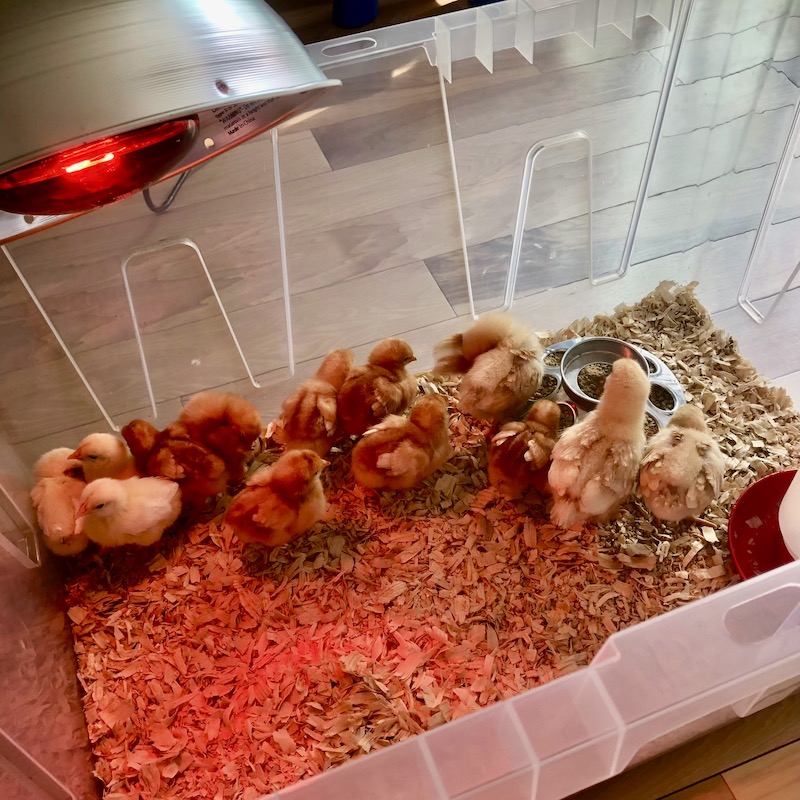

I did notice once they were in the brooder that a couple chicks had globs of dried poop stuck to their butts. The term for it is “pasty butt.” It’s common and deadly if it’s not cleared, because it blocks them from being able to poo. I watched a YouTube video on how to fix it, which essentially just showed rubbing the dried poo glob with a wet towel, until it disintegrated to nothing or fell off. It did the trick, and the chicks were all clean, healthy and happy.
I covered the top of the brooder (as much as I could without getting too close to the heat lamp) with a window screen so the chicks didn’t hop out.
They certainly grew quick. It only took a few days to a week for them to outgrow the brooder, so I had to move them. We had a large old wooden box in our basement that we wanted to get rid of anyway, so we put that to use as the large brooder. It had much taller walls, making it harder for the chicks to jump out.
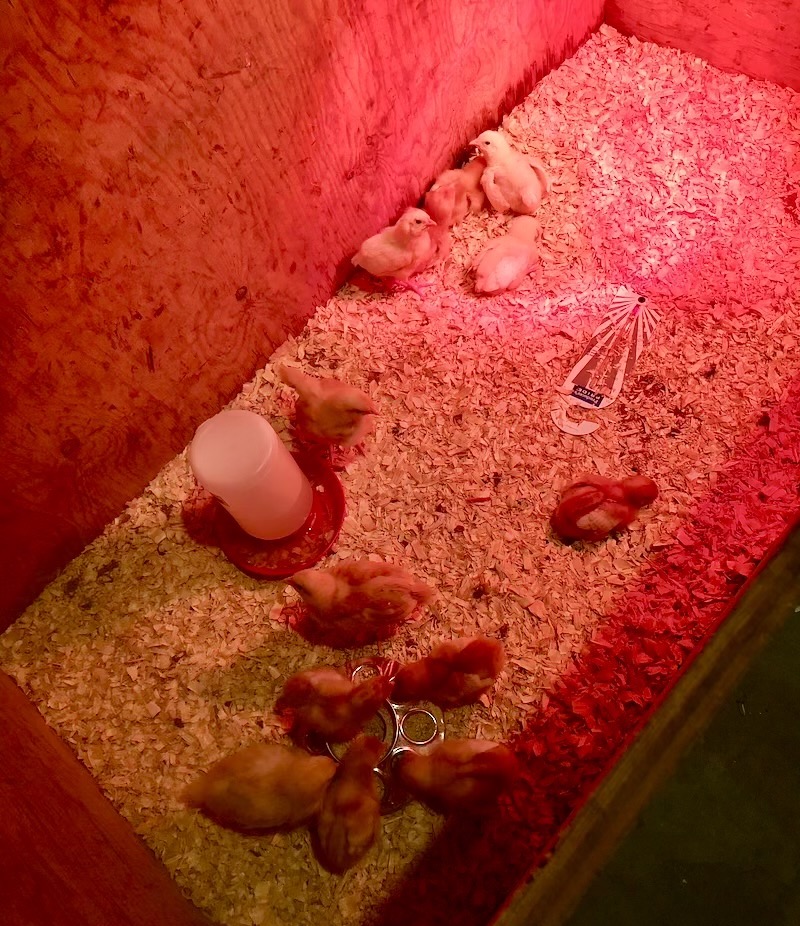

I have to say, I was very nervous during those 6 weeks with the heat lamp constantly on in our house. I went to the basement A LOT every day and even throughout the night to make sure all was good and it was still secured above the brooder. Terrified that it would get knocked off and start a fire, I was thrilled to be able to remove the heat lamp once their feathers came in and the temperatures warmed up.
After painting the exterior of the coop with white and black paint, I did a lime wash on the inside. I had never known of this technique before researching chicken coop care, but it’s really cool. It’s a whitewash of hydrated or mason’s lime (powdered limestone), which can usually be found at a hardware store, mixed with salt and water. It’s only do be done on the inside, otherwise rain will wash it right off. Some benefits of white washing a chicken coop interior with a lime wash is that it has antibacterial properties for keeping the chickens healthy, it deters bugs, keeps the smell down, and brightens up the coop without having to use toxic paint in the chicken’s living space. A very important note to keep in mind is that handling hydrated/mason’s lime can be hazardous, as it is caustic, so make sure to avoid contact with skin and eyes and avoid breathing the dust. Wear gloves, and eye and face protection. Once it’s washed on and dried to the surface, it’s no longer hazardous. For more information on whitewashing, I found this article helpful.
When the wash is first painted onto the surface, it doesn’t look very white, but it brightens up and becomes whiter as it dries. The picture below shows how mine came out. I plan to do another coat this spring.
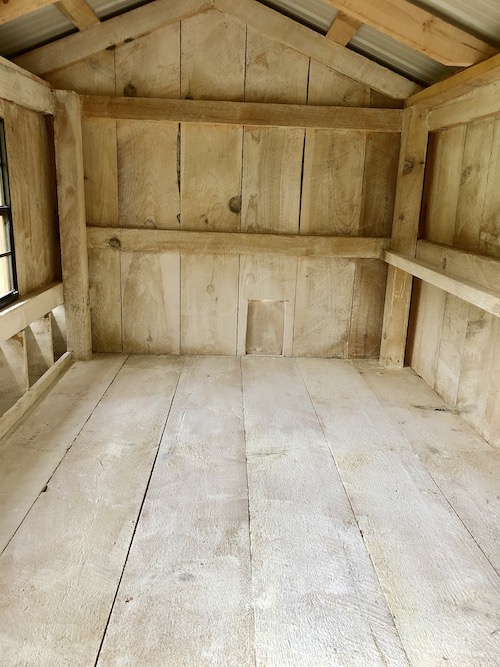

Mid April, the daytime temps got warm enough to introduce the chicks to the outside world. I let them explore the grass for a few minutes during the warmest part of the day while we were outside with them. I put them in the coop during the days, bringing them back to our basement brooder at night until the temperatures warmed up.
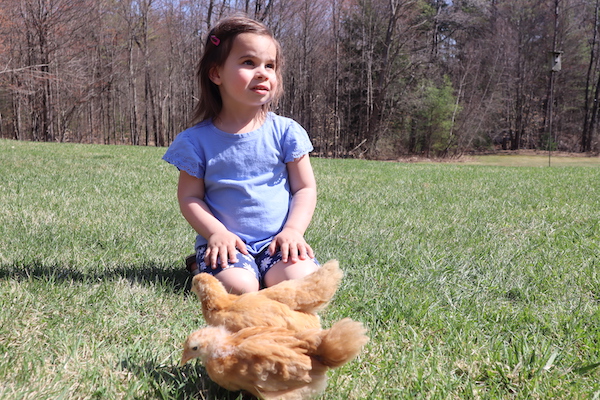

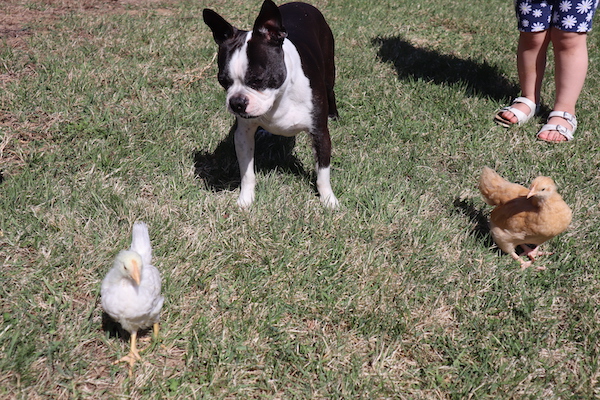

By mid May, they were living in the coop full-time. I kept them inside the coop for the first 1-2 weeks, so they’d learn that was home. At night, all 13 chicks would squeeze in a single nesting box, all piled on top of each other to sleep.
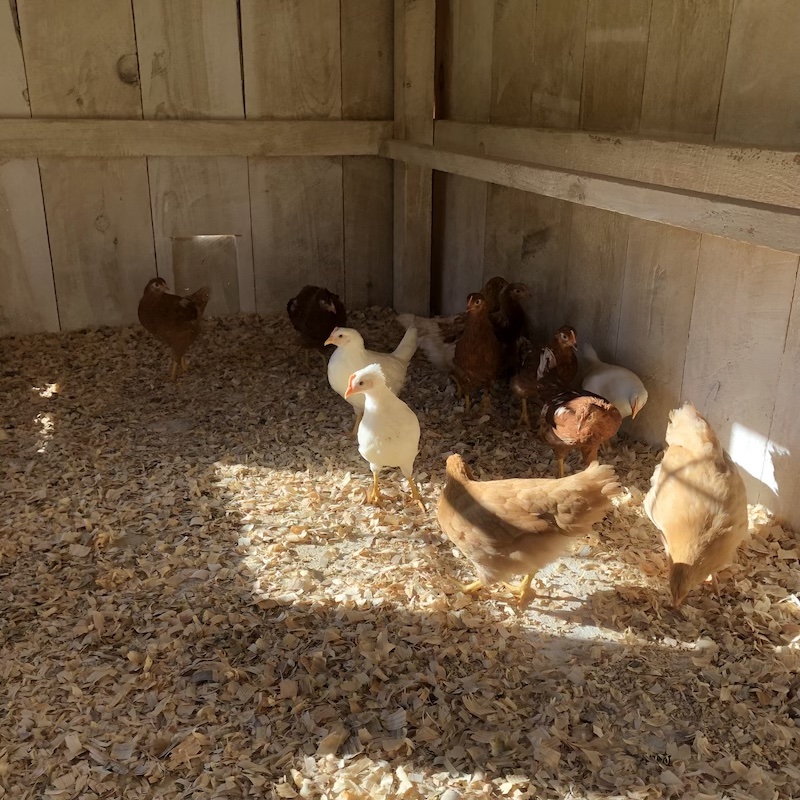

After those first couple weeks inside the coop, I opened their door and let them roam freely. They’d roam throughout the day, and go back in the coop on their own right before the sun went down. Every night around 8pm I’d just have to go close their door to keep night-time predators out.
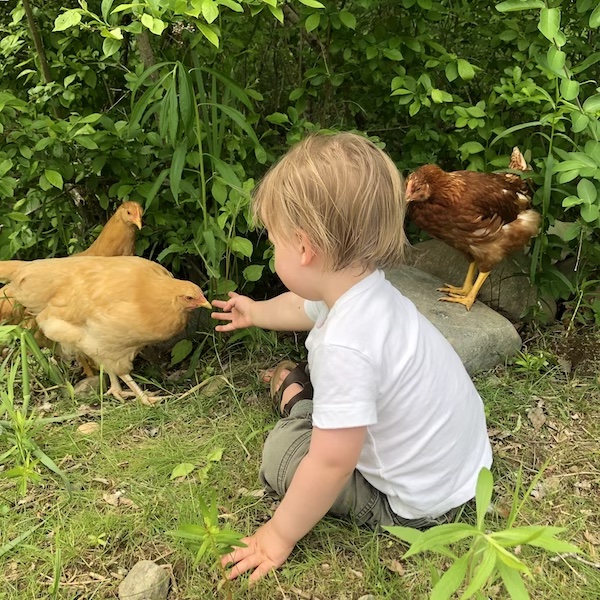

How It’s Been Going
I think we can all say we’ve been enjoying our experience raising backyard chickens. They’ve proved to be entertaining, simple to care for, and the eggs have been excellent. We were lucky because all of the chickens we got turned out to be hens… even thought we bought sexed chicks, the guy at Tractor Supply told me there was a possibility that some could be male/roosters.
Though they have come with some obstacles. Here’s an overview of how it’s been going with adult chickens….
Mid-July we were getting our first eggs (so they were around 4 months old when they started laying). One morning the kids and I went out fill up their food and water, and there was an egg on the ground just outside the coop. It was exciting! Then when I opened the coop, we noticed 3 more eggs inside piled in the corner. A few days later, my husband was mowing the lawn and came across a nest in the tall grass that had 13 eggs 😳 They went from zero eggs to a lot of eggs real quick, but they definitely needed some training to know where to be laying them. So, I loaded their nesting boxes with lots of shavings and placed golf balls inside, hoping they’d resemble eggs to the chickens and they’d get the drift. Instead of letting them roam free, I decided to keep them in the coop for a few days to let them get used to laying in the nesting boxes. That seemed to do the trick. For the most part, they continued laying eggs in the boxes. Every once in a while, we’d find eggs in our mulch beds, in tall grass areas, or even randomly in the middle of the yard.
Oh, and speaking of mulch beds… chickens will destroy them if they have access to them! I gave up last summer on trying to keep our mulch beds nice. They scratched, dug and bathed in them every day. Unfortunately, the mulch beds, the bird feeder, and our porch are the top choice locations for our chickens. I have to figure something out this summer to keep them away from our house, because the mounds of chicken poop has definitely been an issue, and the biggest complaint I hear about from my husband! Im happy to have them pooping in the far yard and fertilizing our lawn, but not so much our deck, walkway and mulch beds! I do want to continue to let them free-range, so I’ll take any recommendations! I’m thinking about installing a mulch bed and bird feeder down by their coop for their own enjoyment, just so they’ll stay away from mine.
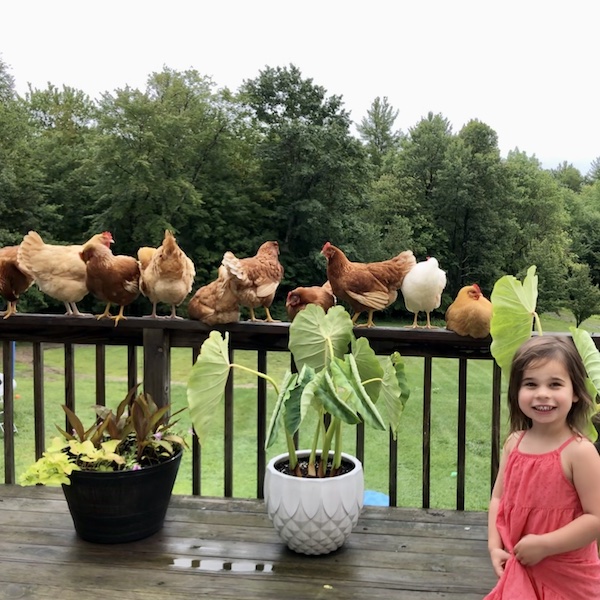

As much as I love having free-range chickens, it hasn’t come without some complication. Aside from the issue with poo around our house, the mulch beds being destroyed, and my garden veggies being eaten, we’ve also had to deal with predator.
Since the day we got our chickens, I’ve been cognitive of a couple hawks that fly over our property. The chickens also always seem to be well aware of the hawks, because they don’t hang out in the open field. They tend to walk around the edges of our property, and when they do cross the yard, they run all together as fast as they can. It’s funny to watch.
So, I always thought that a hawk was the greatest danger to the chickens. It wasn’t. One night, around 6pm, I was washing dishes and my husband came barreling in the house yelling to make sure the kids and dog were inside. He had just pulled in our driveway from work and saw a coyote take off from our yard with one of our chickens in its mouth. I looked out the window and saw the proof of a bunch of feathers in the grass. I went out (with my husband on watch) to get all the others back in the coop. They were so shaken up that they jumped up into the rafters of the coop. It was the only time I had ever seen them do that.
We live in the country, so I knew there was always the possibility of a coyote or a fox, but I had never seen one, and during the day I thought the risk was minimal. I felt terrible.
The next day, I let them out again. Not a great idea. I thought coyotes typically sleep during the day, and since the one came at 6pm, I’d just get them back in the coop by 4. At 2pm, I had just gotten my kids down for a nap when I walked out of their rooms and heard the chickens going nuts. I walked out on the porch and saw a large coyote running after a chicken right next to the house. I had never seen one before, and was shocked to see it was about the size of a German Shepard. It was so much larger than I imagined. I grabbed a pole that happened to be on the porch and just started banging it to make some noise and scare it. I ran in the house to grab my phone and by the time I got back on the porch, the coyote was gone and there were no chickens in sight. I wanted to go look for them, but was too scared, so I called my husband to see if he could hurry home from a job he was in the middle of. I frantically called my dad who only lives next door, and he quickly came down with his hunting gun.
While my dad took a walk around the property, having no luck finding the coyote, I found 10 chickens all huddled under my car in the driveway. I got them back in the coop, hoping the other 2 missing ones would reappear… they didn’t.
I didn’t expect the coyote to come back out that day, but it did. My husband shot at it and it took off. We’re still not sure if he got it or not, but we’re hoping it never comes back.
I went a good few weeks after that eventful day being afraid to let the chickens out, and even let my kids and dog play outside. We built a chicken run on the outside of the coop, so they could still get outside, but stay in a small fenced in area. I also bought this automatic chicken door, which has been very convenient. We did get back to normalcy after some time and I did begin letting them out to free-range again.
I’m always hoping our yard is safe, but I know there’s some risk. I chose to let the chickens out most days now that the weather’s nice (they were cooped up all winter), knowing they have a better quality of life exploring the outside world doing their thing. Their eggs are healthier, I’m hoping they eat the ticks, and they’re fun to watch. All the reasons I wanted to get them in the first place.
All in all, raising backyard chickens has been a fun experience. They’re friendly and entertaining to watch and I love going out every day to collect and count the eggs with the kids. Watching the kids interact with them has been awesome. I love that they get to grow up with animals. While the chickens have been quite a nuisance in the mulch beds and in the garden, they’ve been worth it. And, the pastured eggs are the best! 🥚

*As an Amazon Associate I earn from qualifying purchases.
Some of the links above are “affiliate links.” This means if you click on the link and purchase the item, I will receive an affiliate commission. Regardless, I only recommend products or services that I believe will add value to my readers



